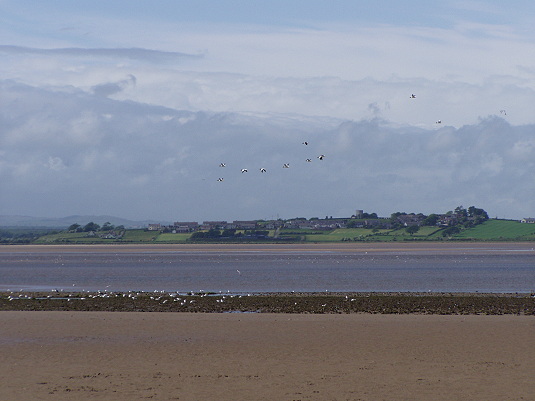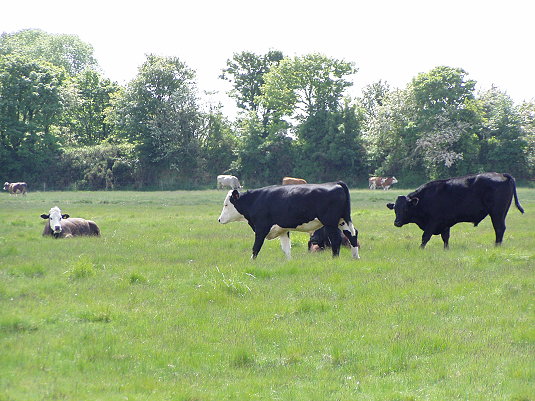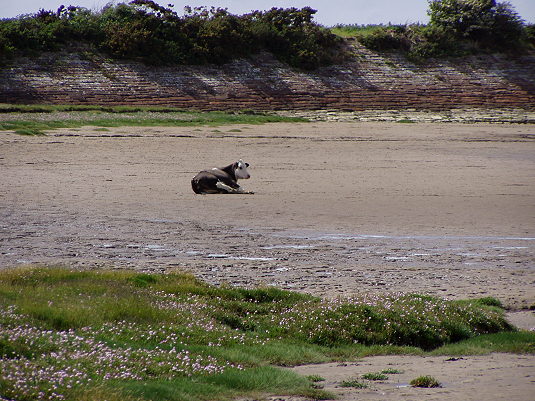5.29.04 Hadrian’s Wall Walk: Bowness-on-Solway
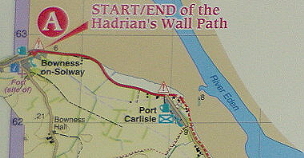
![]()
Location: Northwest England, on the Solway Firth
A “Firth” Is: A long, narrow inlet of the sea
Population: 1,250
Roman Name: Maia
The road into Bowness-on-Solway is tarmac, but there are no lines on it, and two cars could just about squeeze by one another. It’s about as far West as you can get in England without falling into the sea, and actually, the sea comes up to greet it twice a day, at high tides.
I’m here for a day to rest up before the walking begins. No wall around here; there was a fort which encompassed most of the area at some point, but the Solway was an effective enough barrier and the locals over the centuries absorbed a lot of the wall into their stone farmhouses and barns. (The word is from almost everyone that if you want to see the wall this far out, just look at the buildings.)
General Atmosphere: Quiet
Wall Seen: None
Dogs: 8
Terns: 3
Cows Sunbathing: 1
Sunsets Observed: 1
No. Of Newsagents/Bodegas: 0
No. of times asked if Canadian: 2
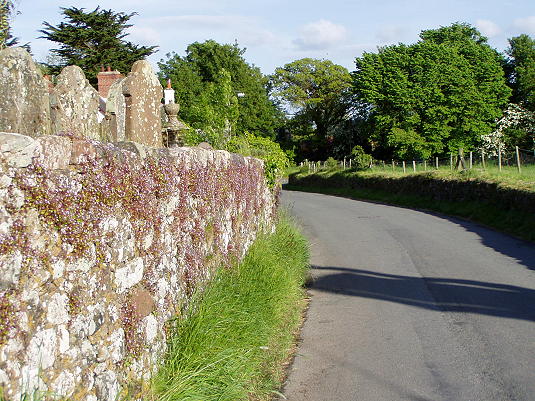 I got in around 2, and the sun was out and full and lovely and the whole place simply glistened and burst with colors. Very quiet – Sundays seem that way wherever I go in England. And no real shops anyway. I had no idea where anyone in town got groceries, but hey, this was a place where the post office was only open twice a week. That, plus houses and a pub called the King’s Arms (no legs! Ha!) made up the whole town. And barns. Close together – no sidewalks, narrow streets – but low to the ground. Homes had names (my favorite: Severus) and the most striking feature of the area was a vast tidal flat which, when I first got there, had bare trickles of water running through it (these became the River Eden further down; more on that in days to come). You could almost walk across the flat to the land on the other side – which is Scotland – but you’d probably need long Wellingtons, because although it’s not wet, it’s not dry either, and the further out I got, the muckier things became. What was most striking is when I went back for sunset later how the water had fully come in and where I had been walking was totally covered over.
I got in around 2, and the sun was out and full and lovely and the whole place simply glistened and burst with colors. Very quiet – Sundays seem that way wherever I go in England. And no real shops anyway. I had no idea where anyone in town got groceries, but hey, this was a place where the post office was only open twice a week. That, plus houses and a pub called the King’s Arms (no legs! Ha!) made up the whole town. And barns. Close together – no sidewalks, narrow streets – but low to the ground. Homes had names (my favorite: Severus) and the most striking feature of the area was a vast tidal flat which, when I first got there, had bare trickles of water running through it (these became the River Eden further down; more on that in days to come). You could almost walk across the flat to the land on the other side – which is Scotland – but you’d probably need long Wellingtons, because although it’s not wet, it’s not dry either, and the further out I got, the muckier things became. What was most striking is when I went back for sunset later how the water had fully come in and where I had been walking was totally covered over.
Lodgings: The Old Rectory
Rating: 8
Chickens At Lodging: 3
Chitty-Chitty-Bang-Bang Cars At Lodging: 1
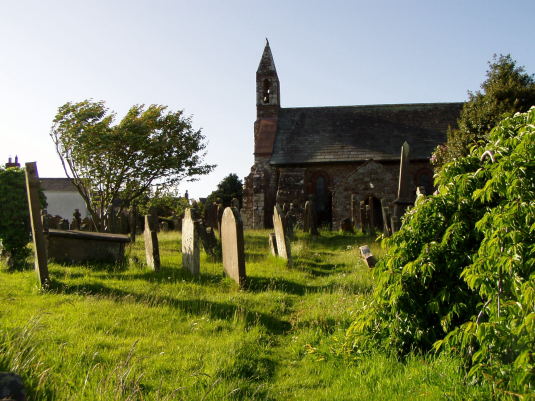 But while it was sunny I went hiking down the road to the flats. People were walking their dogs and children around the area; someone had set out a picnic lunch on a blanket. Cows without a fence (the road on one side, the flats on the other) grazed; one had plopped herself down on the “beach.” In the far distance I noticed two tall posts on the edge of a grassy, rocky cliff – and I wondered if that was some kind of Roman ruin, so I set out.
But while it was sunny I went hiking down the road to the flats. People were walking their dogs and children around the area; someone had set out a picnic lunch on a blanket. Cows without a fence (the road on one side, the flats on the other) grazed; one had plopped herself down on the “beach.” In the far distance I noticed two tall posts on the edge of a grassy, rocky cliff – and I wondered if that was some kind of Roman ruin, so I set out.
Famous Fans Of Bowness-on-Solway
1. Sir Walter Scott (Redgauntlet, 1824)
2. Charles Dickens (1857)
3. Melvyn Bragg
4. Samuel Bough
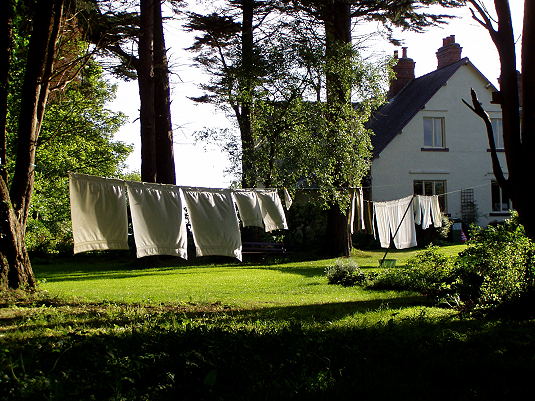 A little history on the Romans in Britain: They showed up in 55 B.C. and stuck around for about 400 years. In 122 A.D., Emperor Hadrian took a look around the Britons, decided it wasn’t worth forging forward to conquer Scotland (whether this has to do with the fierceness of the fighting “barbarian” tribes or that it was, well, Scotland is in debate), so he decided to have his troops build a wall from just past Newcastle to just past Carlisle to keep ’em out, and to have a place to store troops in case there was trouble on either side of the wall. The wall at the time was about 20 feet wide at the base and about 12 feet high. Every Roman mile (shorter than the English mile) featured a fort-let or “milecastle,” which was about 50-60 feet square and had a small garrison. Between each milecastle were two towers (“turrets”). The wall was built of stone with a limestone mortar in the East, and when they ran out of mortar they stuck with turf at first, then moved on to stone in later years. The fort in Bowness was “Maia,” which meant “larger” and covered an area of 5.88 acres. Anyway, more on this as we go.
A little history on the Romans in Britain: They showed up in 55 B.C. and stuck around for about 400 years. In 122 A.D., Emperor Hadrian took a look around the Britons, decided it wasn’t worth forging forward to conquer Scotland (whether this has to do with the fierceness of the fighting “barbarian” tribes or that it was, well, Scotland is in debate), so he decided to have his troops build a wall from just past Newcastle to just past Carlisle to keep ’em out, and to have a place to store troops in case there was trouble on either side of the wall. The wall at the time was about 20 feet wide at the base and about 12 feet high. Every Roman mile (shorter than the English mile) featured a fort-let or “milecastle,” which was about 50-60 feet square and had a small garrison. Between each milecastle were two towers (“turrets”). The wall was built of stone with a limestone mortar in the East, and when they ran out of mortar they stuck with turf at first, then moved on to stone in later years. The fort in Bowness was “Maia,” which meant “larger” and covered an area of 5.88 acres. Anyway, more on this as we go.
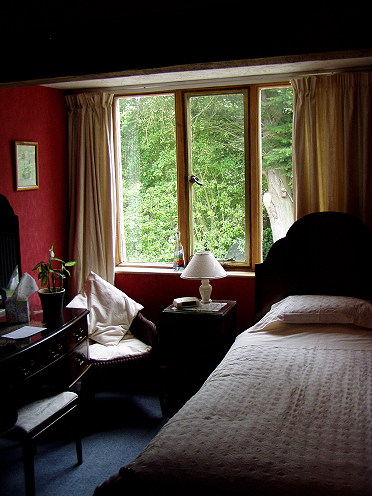 I strode to the pillars and scrambled up the rocky wall to find they were just rusting posts; the area around them had twisted metal parts and crumbled stone, then swept up a dozen feet to the edge of a grassy cliff. On the Scottish side of the Solway you could see another, similar, raised area. And before I could even decide for myself what it was, this thin, mustached man about my age or a bit older strode up with his two dogs (Jessie and Sam) and explained how there once had been a rail line that connected Bowness to the Scottish side, but, as he pointed out and I realized, the pilings had been sunk in, well, tidal flats and it was doomed. They gave up on it around 1818. There was one other problem: You couldn’t drink in Scotland on Sundays at the time, and the Scots used to walk across the bridge to come into town to drink, then go tottering back on the same rail line and often fell off. And died. Must have been amazing booze.
I strode to the pillars and scrambled up the rocky wall to find they were just rusting posts; the area around them had twisted metal parts and crumbled stone, then swept up a dozen feet to the edge of a grassy cliff. On the Scottish side of the Solway you could see another, similar, raised area. And before I could even decide for myself what it was, this thin, mustached man about my age or a bit older strode up with his two dogs (Jessie and Sam) and explained how there once had been a rail line that connected Bowness to the Scottish side, but, as he pointed out and I realized, the pilings had been sunk in, well, tidal flats and it was doomed. They gave up on it around 1818. There was one other problem: You couldn’t drink in Scotland on Sundays at the time, and the Scots used to walk across the bridge to come into town to drink, then go tottering back on the same rail line and often fell off. And died. Must have been amazing booze.
So, no train. (The pilings and the grassy cliff and the drop into the flats reminded me of the the original Get Carter, which climaxed on a beach (spoiler alert). Anyway, I was reminded of the film, then came home and found out the picture was filmed in Newcastle originally! So my geography isn’t too bad off. Kind of.) In any case, my informant’s name was John and he was a truck driver who did the night shift and often drove to Aberdeen.  Tires. He drove tires. Nice guy; as we talked a couple with their four (!) dogs scrambled up and began watching the birds on the tidal flats. John left and I joined them, playing with the dogs and chatting. They had binoculars and set up a tripod to examine the birds, letting me peer through once or twice. These were serious bird-watchers, and very excited about seeing terns. I wanted to make a joke about how one good tern deserves another, but decided we were on a high cliff and there could be trouble. When they left, I also headed back and got ready for dinner.
Tires. He drove tires. Nice guy; as we talked a couple with their four (!) dogs scrambled up and began watching the birds on the tidal flats. John left and I joined them, playing with the dogs and chatting. They had binoculars and set up a tripod to examine the birds, letting me peer through once or twice. These were serious bird-watchers, and very excited about seeing terns. I wanted to make a joke about how one good tern deserves another, but decided we were on a high cliff and there could be trouble. When they left, I also headed back and got ready for dinner.
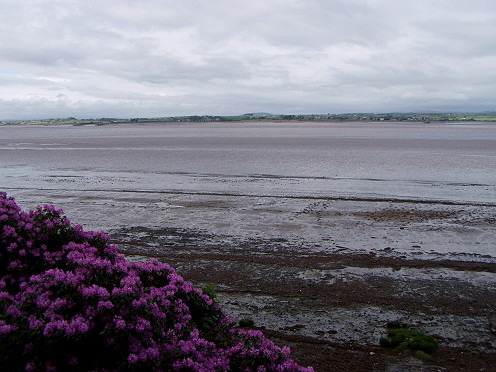 That was another story: the Rectory didn’t provide meals beyond breakfast (and a packed lunch for me to take on my walk), but the King’s Arms did. I had paid in advance for a company called Trek-Inn (no longer in business as of 2012) to a) book me in my lodgings near the wall b) organize my breakfast, pack lunch and dinner each night and c) provide maps and directions. Needless to say, while 98% of things went just fine, those 2 percent that didn’t were awkward. The King’s Arms had not been alerted to my meal being paid for ahead of time, and while I could have paid for it, I felt like I already had, so I called the Rectory owner. On his cell. He got on and said “where are you?” and I said “King’s Arms.” And there he was, on a table on the other side of the pub. Heh. He took care of it and said he’d clear things with Trek-Inn.
That was another story: the Rectory didn’t provide meals beyond breakfast (and a packed lunch for me to take on my walk), but the King’s Arms did. I had paid in advance for a company called Trek-Inn (no longer in business as of 2012) to a) book me in my lodgings near the wall b) organize my breakfast, pack lunch and dinner each night and c) provide maps and directions. Needless to say, while 98% of things went just fine, those 2 percent that didn’t were awkward. The King’s Arms had not been alerted to my meal being paid for ahead of time, and while I could have paid for it, I felt like I already had, so I called the Rectory owner. On his cell. He got on and said “where are you?” and I said “King’s Arms.” And there he was, on a table on the other side of the pub. Heh. He took care of it and said he’d clear things with Trek-Inn.
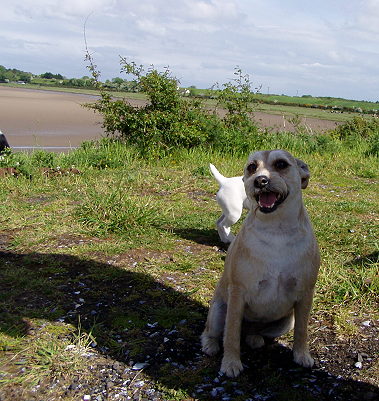 Then I dined. Decent stuff, fish I believe. The waitress was a bit snotty about the whole mess, though; I found that while many owners were generous in some ways they could be very off-putting at the least instance of trouble. The Rectory owners were very kind. Earlier that evening, I had wandered around the front and back yard area, where they kept chickens and let their whites hang out to dry. I also found a battered old copy of the Chitty Chitty Bang Bang car, GEN-II, and asked them later: Turns out the town had an annual parade of floats; the year before it was movie musicals. But, she added, the woman who had orgnanized it for years had retired and no one had stepped up to fill in the gap. So there’s Chitty, sitting in a backyard, as if Jemima and Jeremy will come to claim her again any day now!
Then I dined. Decent stuff, fish I believe. The waitress was a bit snotty about the whole mess, though; I found that while many owners were generous in some ways they could be very off-putting at the least instance of trouble. The Rectory owners were very kind. Earlier that evening, I had wandered around the front and back yard area, where they kept chickens and let their whites hang out to dry. I also found a battered old copy of the Chitty Chitty Bang Bang car, GEN-II, and asked them later: Turns out the town had an annual parade of floats; the year before it was movie musicals. But, she added, the woman who had orgnanized it for years had retired and no one had stepped up to fill in the gap. So there’s Chitty, sitting in a backyard, as if Jemima and Jeremy will come to claim her again any day now!
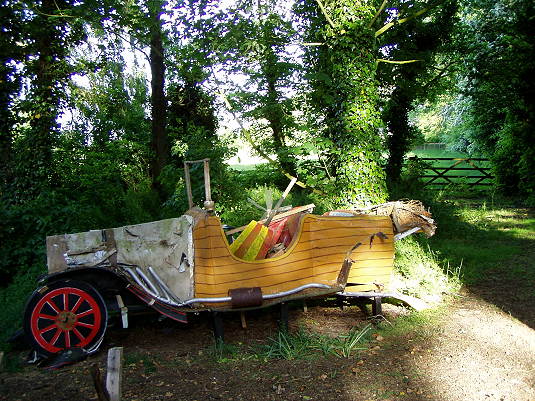 After dinner I headed back to the flats for the sunset. Always try to squeeze in a sunset whenever possible, and this was as West as I could get, so – perfect.
After dinner I headed back to the flats for the sunset. Always try to squeeze in a sunset whenever possible, and this was as West as I could get, so – perfect.
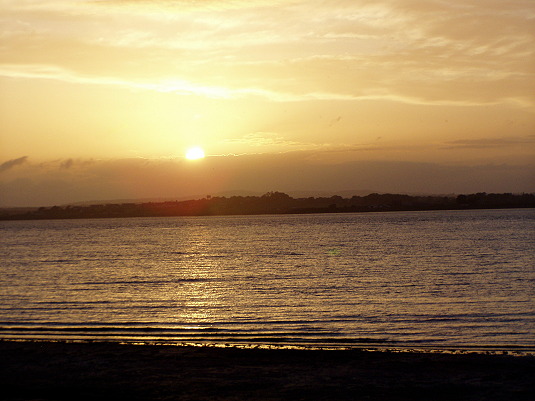 Tomorrow’s walk: 15 miles. I watched some TV and rightly went to sleep after reading from a Jeffrey Archer book of short stories that was very, very bad.
Tomorrow’s walk: 15 miles. I watched some TV and rightly went to sleep after reading from a Jeffrey Archer book of short stories that was very, very bad.
[paypal-donation]
